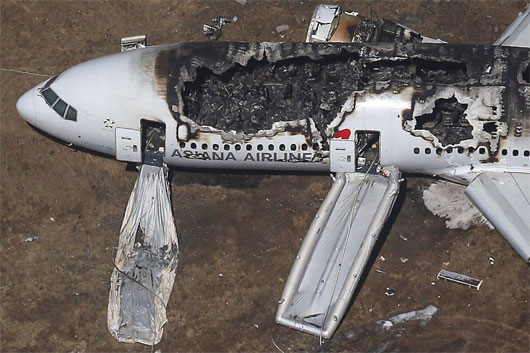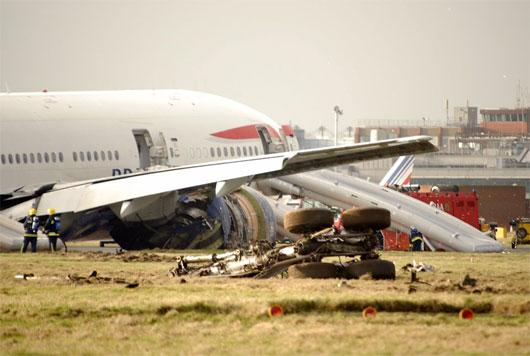Notable accidents involving Boeing 777
The Boeing 777 is a twin-engine wide-body jet aircraft, dedicated to long-haul flights produced by Boeing Commercial Airplanes. Not only is the largest jet model, the Boeing 777 is also a model of aircraft commonly used by airlines around the world and extremely safe.
According to Fearofflying, Boeing 777 ranked second only to Airbus A340 with only 1 accident / 8 million flight hours. Therefore, the disappearance of Malaysia Airlines Boeing 777-200ER has surprised the professionals. While waiting for new discoveries about the incident, let us review the remarkable accidents involving Boeing 777 to see why the Boeing 777 has always been hailed as one of the jets. The safest trade in the world.

Asiana Airlines' Boeing 777-200ER had an accident at San Francisco airport last year
Boeing 777 began production in 1993 and was first introduced in July 1995 with the first airline to operate, United Airlines (USA). For nearly 19 years, the Boeing 777 has been developed with multiple versions corresponding to body length and range. Boeing 777 versions include 777-200, 777-200ER, 777-200LR, 777-300, 777-300ER, 777F and 777X. The Malaysia Airlines plane crashed was a 1997 Boeing 777-200ER of the B segment (maximum range of 12,200km). A total of 422 Boeing 777-200ERs were shipped by 2013 and Malaysia Airlines owned 15 aircraft. Particularly Vietnam National Airlines (Vietnam Airlines) also has 4 same type aircraft being exploited on international flights.
Since the operation and before the disappearance of Malaysia Airlines MH370 on March 8, the Boeing 777 has encountered 10 accidents and incidents large and small. Including 3 accidents causing hull-loss and 3 hijackers.

The scene of British Airways Flight 38 crash at Heathrow airport
The first hull-loss accident occurred with British Airways flight number 38. On January 17, 2008, a Boeing 777-200ER with a Rolls-Royce Trent 895 engine flying from Beijing to London had a problem in the final approach to the 27L runway at Heathrow Airport. The problem with the engine made the pilot unable to increase the thrust from the autothrottle system and at a height of 61m, the aircraft's speed dropped to 108 knots (200km / h). Pilots have to break the autopilot mode and try to land the plane by reducing the flap angle from 30 to 25 degrees to increase the braking force and allowing the plane to fly down the runway. As a result, the Boeing 777 collided with the runway, slipped to a moving landing line (displaced threshold). There were 47 passengers injured but no one died. The accident ruined all landing gear, wing roots and engines.

Tapes on the Boeing 777 FOHE oil converter in distress
Through investigation, the cause of the accident was determined because the ice crystals from the fuel system sealed the oil thermostat (FOHE) converter, reducing engine thrust while landing. In 2009, aviation incident investigators asked Rolls-Royce to redesign the unit on the Trent 800 series. The re-designed FOHE thermos have been replaced on British Airways Boeing 777 in October of the same year.

The Boeing 777-200ER cockpit of EgyptAir badly damaged after the fire
The second hull-loss incident happened on July 29, 2011 when EgyptAir's Boeing 777-200ER (Egypt) encountered a fire in the cockpit when passengers were boarding at a waiting port. Cairo international airport. Passengers and crew on the flight have been safely rescued and have no human damage. However, the aircraft was badly damaged and according to investigators, the failure of the electronic system with the oxygen supply pipes in the cockpit could be the cause of the fire.

Asiana Airlines' Boeing 777-200ER was almost destroyed after a failed landing at San Francisco airport
The 3rd hull-loss accident and also the first human injury accident occurred on July 6, 2013 with Asiana Airlines flight number 214 (South Korea). The Boeing 777-200ER flew 291 passengers and 16 crew members flying from Icheon International Airport (South Korea) having trouble landing at San Francisco International Airport. In the final approach to the 28L runway, the landing and tail of the aircraft hit the sea wall at the end of the runway. The impact caused the engine and tail to fall out of the plane, the remaining fuselage and two wings rotated counterclockwise by 330 degrees and slid on the runway. The plane stopped at the ground to the left of the runway, 730m from the initial collision location. Do not stop there, just a minute later, black smoke rises and the fire spreads to oil seeping from the engine and ignites. The rescue network on the left side of the aircraft was immediately deployed to evacuate passengers and the rescue force at the airport was also quickly on the scene. The accident killed three Chinese passengers (one of whom crashed out of the plane and was killed by a fire truck), 181 were wounded, the total number of survivors including the crew was 304. people.
The National Transport Safety Committee (NTSB) analyzed data from the black box and made the final conclusion about the accident with the cause of the pilot error. Specifically, the pilot responsible for controlling Lee Gang Guk aircraft is still in training with Boeing 777 aircraft. Although he has more than 10,000 hours of flying with many aircraft, Lee only has 33 hours to fly with Boeing 777. Meanwhile, the pilot guiding Lee Jeong Min has gone through 3,220 hours of flying with Boeing 777. In charge of controlling the landing plane, Lee Gang Guk told the investigation team that he felt "very stress " and the landing " is very difficult to implement " with a large aircraft like the Boeing 777 and the lack of an electronic system that helps track the glider of the aircraft due to maintenance.
The incident has greatly affected the reputation of Asiana Airlines and the company has reformed its pilot training program to ensure the ability to control many types of aircraft and the necessary skills to land and use the system. autopilot . On February 25, 2014, the US Department of Transportation (DOT) fined Asiana Airlines USD 500,000 for not updating information about the accident in time for the victim and the victim's family.

Boeing 777-200ER with Malaysia Airlines 9M-MRO registration code has been missing (photo taken when the aircraft took off at Charles De Gaulle airport, France, October 2011)
And at 1:22 am on March 8, Malaysia time, the Boeing 777-200ER carries the flight with the number MH370 of Malaysia Airlines and carries 239 people (227 passengers and 12 crew members). While on the road from Kuala Lumpur, Malaysia to Beijing, China lost contact with the Subang air traffic control station. At 2:40 am, the plane was reported to have disappeared off the Gulf of Thailand. Search and rescue activities were quickly deployed with the participation of 6 countries including the US, China, Philippines, Malaysia, Singapore and Vietnam. Until now, the search activity is still going on actively and the authorities have not yet confirmed whether the plane has fallen into the sea or not despite the spill and some debris have been discovered at suspect area in the southern coast of Tho Chu island of Vietnam.
The plane crashed was Boeing 777-200ER with 9M-MRO registration number. This is a new aircraft transferred by Boeing to Malaysia Airlines on May 31, 2002. According to the airline, the aircraft has experienced 20,243 flight hours and 3,023 flights since it entered service. Its most recent maintenance was carried out in February this year. The plane also had a serious accident at Shanghai International Airport while moving on the ground. The wing tip of the aircraft was badly damaged after hitting the tail of an Airbus A340-600 of China Eastern Airlines in August 2012. Regarding the mysterious disappearance of flight MH370, many theories have been put forward, but the reasons for the weather and technical problems identified are very unlikely. In addition, before disappearing, MH370 did not broadcast an emergency signal, along with the discovery of two passengers on the plane using a fake passport, experts and the US Federal Bureau of Investigation (FBI). doubt about the possibility of MH370 being attacked by terrorism.
Through the incidents mentioned above, it can be said that the Boeing 777 is a very safe aircraft with the number of accidents as well as very low human losses during 19 years of operation. In the worst case scenario, if Malaysia Airlines' Boeing 777 falls into the Pacific Ocean, the crash will have a significant impact on the Boeing 777's safety performance.
- 4 aircraft accidents hit the most terrible mountain in history
- Overview of super safe Boeing 777 aircraft
- Self-driving cars appear on the streets of Japan
- Boeing 737 MAX - What is the most special thing in the world?
- See Boeing's most famous but upcoming model of the garden
- Boeing supercar has been discontinued globally
- Malaysia Airlines Boeing 777 lines
- The process of assembling the best-selling model of Boeing aircraft in history
- The first sight of Vietnam Airlines Boeing 787 shipped in the US
- Why are passengers being sucked out in a plane crash carrying 149 people?
- Boeing tests the Starliner spacecraft
- The whole secret survives in a car accident
 'Fine laughs' - Scary and painful torture in ancient times
'Fine laughs' - Scary and painful torture in ancient times The sequence of numbers 142857 of the Egyptian pyramids is known as the strangest number in the world - Why?
The sequence of numbers 142857 of the Egyptian pyramids is known as the strangest number in the world - Why? History of the iron
History of the iron What is alum?
What is alum?